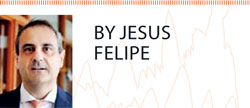14 Jul 2017 - {{hitsCtrl.values.hits}}

 Imagine reading this in your daily newspaper:
Imagine reading this in your daily newspaper:
Since 1970, when France reached the high-income status, its per capita income has been sandwiched between those of the Republic of Korea and Switzerland.
France is in the high-income trap. It can compete neither with the Republic of Korea, nor with Switzerland. This is a great national concern. The government should implement policies to get France out of this trap and turn France into a super high-income economy – one of the three richest in the world.
If you think it sounds a bit odd, you are right. The point is that the alleged story is the same as that behind the idea of the middle-income trap, namely that countries in the middle-income per capita range find it difficult to compete with both the low-income economies and the high-income economies.
Somewhat tautologically, yes, a US $ 8,000 per capita income economy is between a US $ 1,000 per capita income economy and a US $ 30,000 per capita income economy.
This does not mean, however, that the US $ 8,000 per capita income economy cannot ‘compete’ with the other two or have a comparative advantage over them in the production and export of some products.
What some people refer to as the ‘middle-income trap’ is therefore an incorrect and dangerous characterization of how countries develop. If this were the case, perhaps it might be better to remain a low-income economy?
Surely France, Korea and Switzerland produce different goods and services. This is reflected in different wages and, consequently, different incomes per capita.
These differences are ultimately the result of the characteristics of the goods and services that each of them produces, with different levels of complexity and income elasticities of demand.
Income elasticity
The complexity of an economy can be measured by how diversified it is (i.e., how many products it produces with comparative advantage, something quantifiable) and by how unique the products that it produces are (also quantifiable).
The income elasticity of demand of a product measures the percentage increase in the demand of the product when consumers’ incomes increase by one percentage point.
For instance, a US $ 1,000 Mont Blanc pen and an expensive and technologically advanced Siemens medical device are products with a high-income elasticity of demand. So is a US $ 100 bottle of French perfume. On the other hand, a US $ 3 pair of rubber slippers is a product with a low-income elasticity of demand.
Advanced economies pay higher wages (and hence their per capita income is higher) because they produce more complex baskets of products and these have higher income elasticities of demand than middle and low-income economies.
An economy with a per capita income of US $ 8,000 will most likely not compete with a US $ 1,000 per capita income economy in the production of simple textiles and footwear.
Likewise, a US $ 30,000 per capita income economy will not be able to compete with a US $ 8,000 per capita income economy in the assembly of electronic products.
The US $ 30,000 per capita economy will, however, be more competitive in making advanced machinery, chemicals and fancy consumer products. This is simply what development has always been about.
Certainly, the US $ 8,000 per capita income economy would like to become a US $ 30,000 per capita income economy. This does not mean that the former is stuck. In fact, the historical evidence shows that countries progress.
While in 1950 the world only had three high-income countries, today it has over 30. Moreover, historical experience shows that it took most advanced economies many decades to traverse the middle-income segment, in some case over 100 years.
Historically, it took an average of about 70 years to traverse the middle-income segment into the high-income bracket. The comparison with Korea—which traversed the middle-income segment in just 26 years—is misleading. It is an outlier, not representative of the speed at which most countries have progressed.
No leapfrogging
Most Asian countries entered the middle-income bracket just a few decades ago and are still far from the 70-year historical average, thus the fear of being stuck is unwarranted.
Yes, policymakers would like their economies to progress faster. However, conceptualizing the world as one where countries reach the middle-income segment and get stuck (or run the risk of being stuck) is dangerous for policy purposes.
So too is the idea that jumping from low- to middle-income status is easier than from middle- to high-income. The argument is that the first jump requires copying others’ technologies, while the second jump demands more creativity and new technologies.
This is a tremendous simplification and mischaracterization of development and of how per capita income increases.
Using others’ technologies is a slow and painstaking process that requires lots of learning and mastering capabilities. There is no such thing as leapfrogging.
Taking my fictitious example about France to the extreme, there are only two countries in the world not stuck in some middle: the poorest and the richest. All others have a problem.
I just come from a workshop in a Southeast Asian country where a large part of the audience believed that the economy is in the middle-income trap. It was somewhat strange.
The economic situation has deteriorated somewhat during the last few years, but the country is not trapped. Many in the audience were happy to hear so. Growth has declined almost everywhere in the world.
Policymakers need to think about how to further diversify and upgrade the structure of the economy because this is the only way for wages and per capita income to increase in the medium to long run.
These two key aspects of development should be the anchors of national strategies. There’s no need to be pessimistic, much less trapped by a concept that only exists in the mind of some.
(Jesus Felipe is an Advisor, Economic Research and Regional Cooperation Department, the Asian Development Bank)
07 Jan 2025 7 hours ago
07 Jan 2025 7 hours ago
07 Jan 2025 8 hours ago
07 Jan 2025 07 Jan 2025
07 Jan 2025 07 Jan 2025